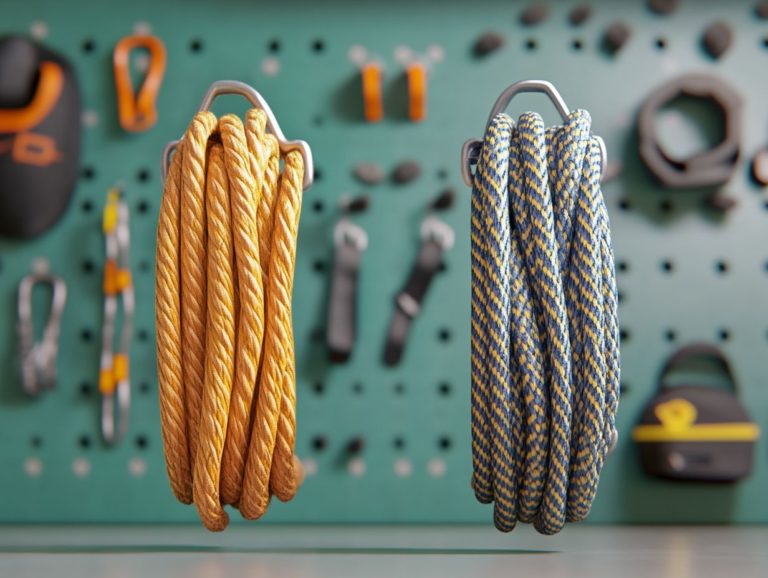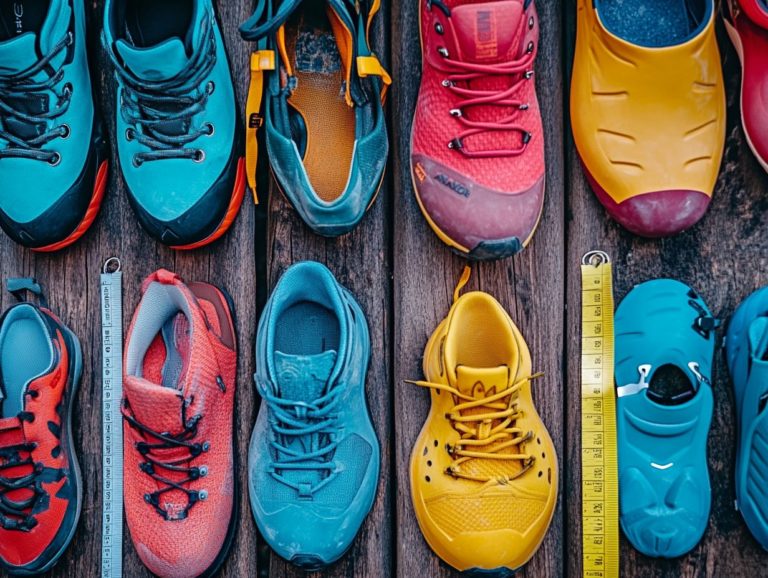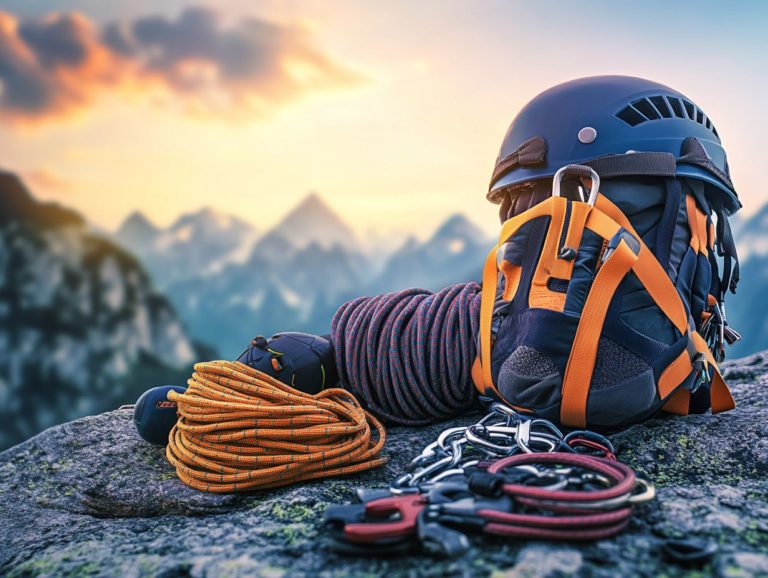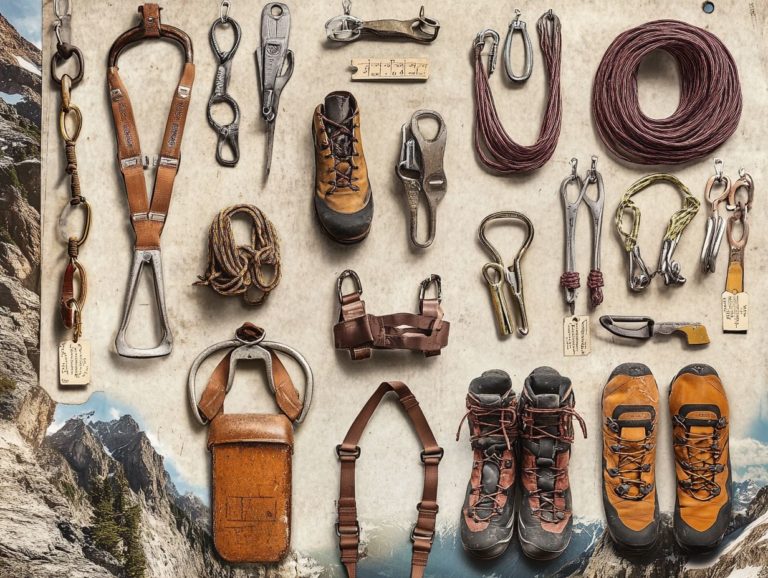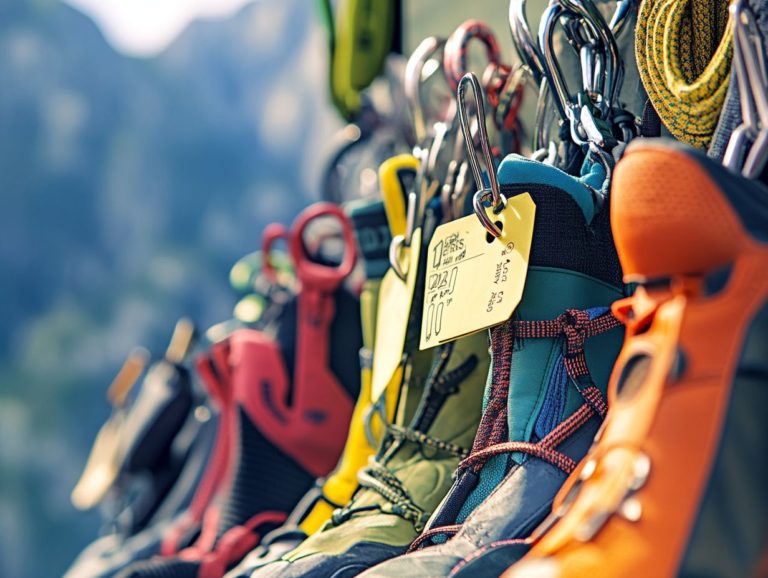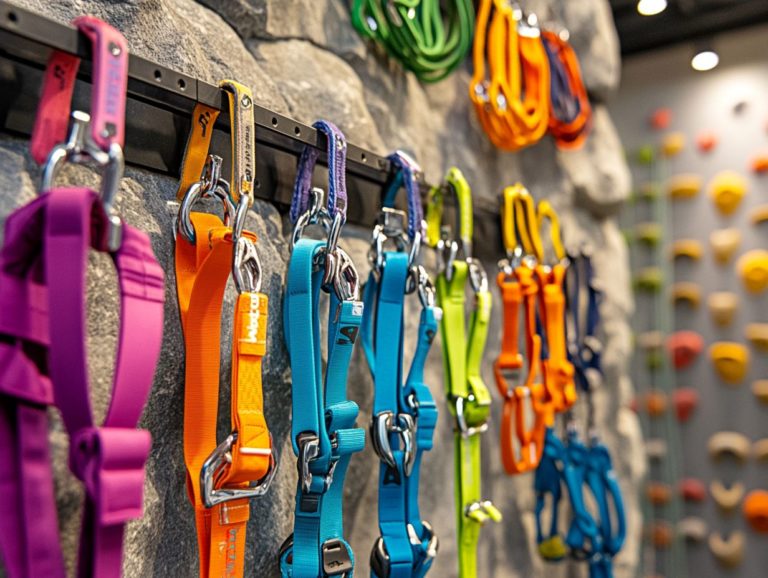Understanding Carabiners: A Climber’s Guide
Carabiners are essential gear for climbers, adventurers, and outdoor enthusiasts. Their utility extends far beyond the realm of rock climbing. Understanding these versatile tools is key to ensuring safety and efficiency in a variety of activities.
This article delves into what carabiners are, the different types available, and how to select the right one to suit your needs. You ll also discover best practices for their use and care, debunk common myths, and uncover safety tips that guarantee a climbing experience that’s not only secure but also enjoyable.
Dive into the world of carabiners with us, and elevate your outdoor adventures!
Contents
- Key Takeaways:
- What Are Carabiners?
- The Different Types of Carabiners
- Choosing the Right Carabiner
- Proper Use and Care of Carabiners
- Common Misconceptions about Carabiners
- Safety Tips for Climbing with Carabiners
- Frequently Asked Questions
- What is a carabiner and why is it important for climbing?
- What are the different types of carabiners and how do I know which one to use?
- What is the difference between the strength ratings of carabiners?
- Can carabiners be used for anything other than climbing?
- How often should I replace my carabiners?
- How should I care for my carabiners?
Key Takeaways:
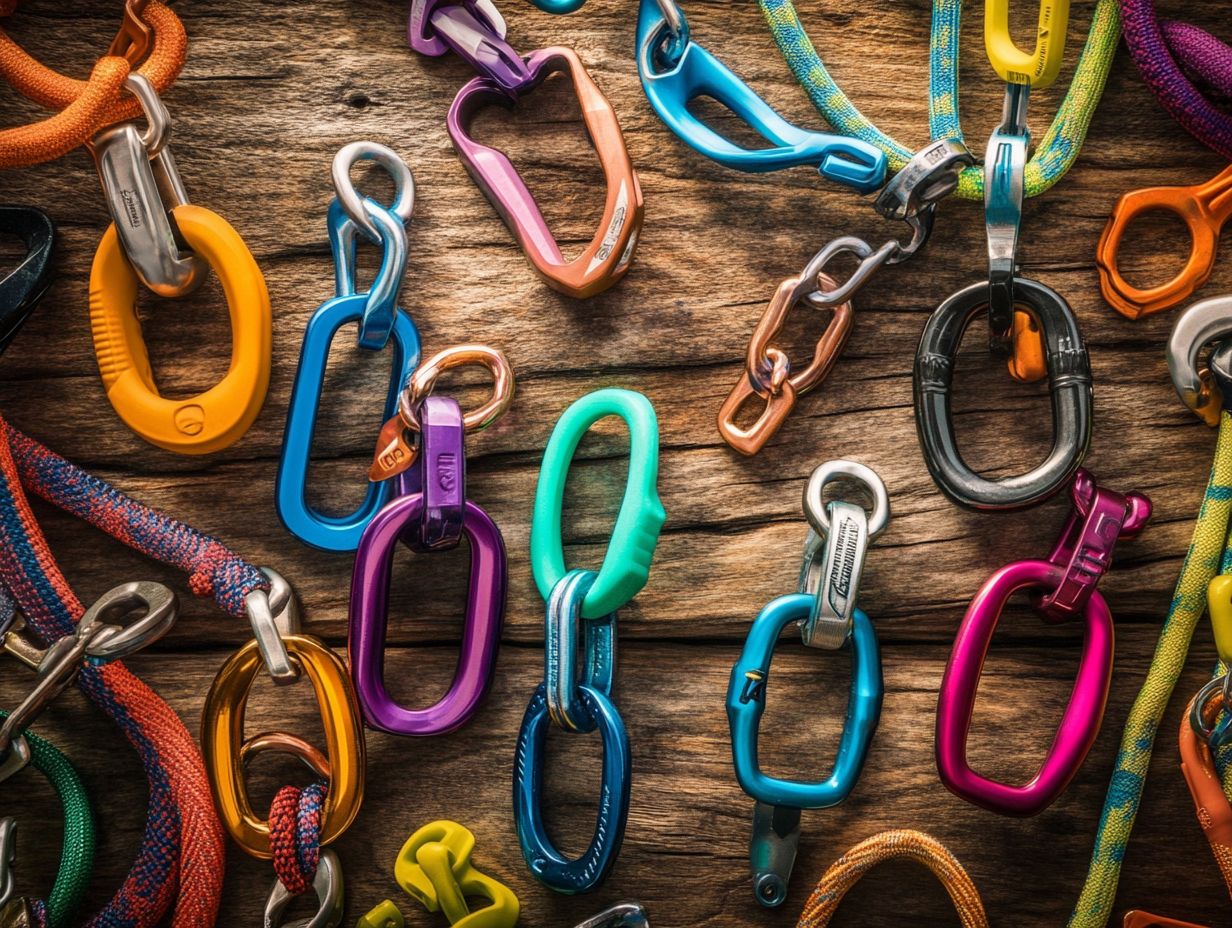
- Carabiners connect your gear and keep you safe while climbing. Discover the different types to find the perfect fit for your adventure!
- Choosing the right carabiner is essential for your safety and success. Know the facts to climb smarter!
- Don’t let myths derail your climbing experience. Equip yourself with the right knowledge for a safer adventure!
What Are Carabiners?
A carabiner is more than just a piece of climbing gear; it s an essential tool that secures your ropes, anchors you as a climber, and ensures your safety on the ascent.
Typically crafted from durable materials like aluminum or steel, carabiners come in various designs, such as D-shape and oval forms, each tailored for specific climbing needs and actions.
Over the past 150 years, they’ve evolved significantly, introducing innovative locking mechanisms like spring-loaded gates that enhance their reliability in belay systems and protection strategies.
Understanding carabiners is key to unlocking new heights in your climbing adventures!
The Different Types of Carabiners
You ll find several types of carabiners, each crafted with specific characteristics and purposes in mind, such as D-shape, oval, snap-gate, bent-gate, and wire-gate designs. Each type presents its own unique advantages and disadvantages, ultimately guiding your choice based on the task at hand be it belaying, securing gear, or connecting to anchors.
It s crucial to understand these variations when selecting the right carabiner for your climbing needs. Some designs offer better load distribution and strength on the major axis, while others shine in lightweight applications. Choosing wisely can make all the difference in your climbing experience.
Key Characteristics and Uses
The key characteristics of carabiners center on their strength, weight, design, and features all of which significantly impact their performance in climbing scenarios.
Each carabiner is crafted to meet specific requirements, with strength ratings indicating the amount of force they can endure. This is typically measured in kilonewtons, a unit of force used to measure strength. For you, selecting the right type can truly make the difference between safety and risk. Understanding weight considerations is essential, as heftier carabiners can weigh you down during an ascent.
You’ll find various designs tailored to different climbing activities be it sport climbing, trad climbing, or mountaineering. Essential locking mechanisms are crucial, as they prevent cross-loading, which can result in energy loss and potential failure. These features ensure that you maintain both performance and safety, even in the most challenging environments.
Choosing the Right Carabiner
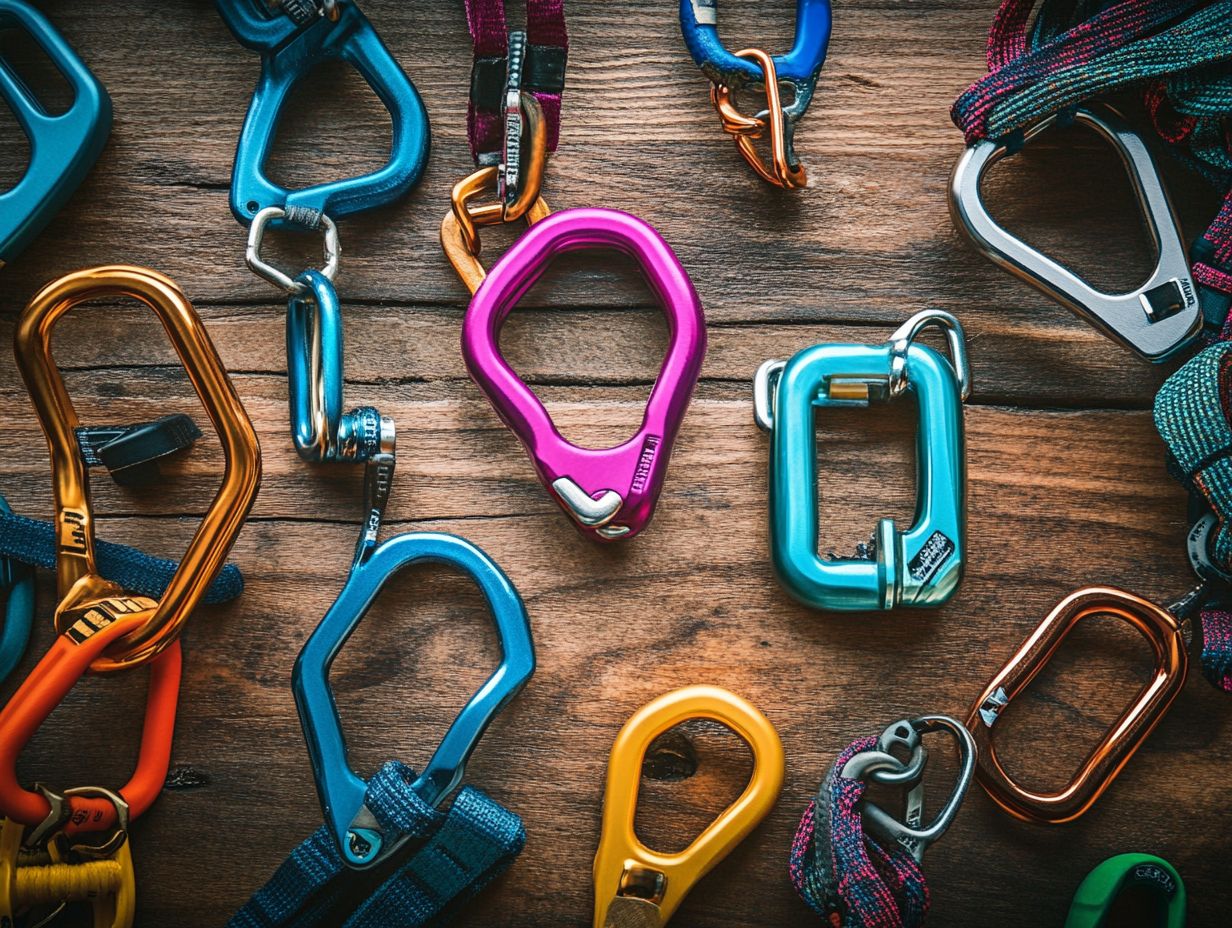
Selecting the right carabiner is crucial for any climber. It requires careful consideration of several factors, such as strength, weight, design, and locking mechanism.
Your ideal carabiner should adhere to safety standards and align with the specific demands of your climbing scenario whether you re belaying, anchoring, or securing gear.
Grasping the balance between weight and strength is essential, especially if you lean toward minimalism while still prioritizing safety in dynamic climbing situations.
Ready to explore the world of climbing with confidence? Let’s gear up and get started!
Factors to Consider
When selecting a carabiner, you ll want to consider several essential factors, including:
- Safety
- The locking mechanism
- Weight
- Strength
- The various types tailored for specific climbing activities
Each of these elements is crucial to ensuring that you can pursue your passion for climbing safely and effectively.
For instance, grasping the strength ratings is vital to preventing catastrophic failures, especially in high-stakes scenarios like multi-pitch climbs. The type of locking mechanism you choose be it a screw lock, auto-lock, or twist lock can significantly impact both ease of use and reliability when it matters most.
Weight is particularly critical for those tackling alpine terrains, where every ounce counts. Additionally, the type of carabiner you opt for, whether oval, D-shaped, or pear-shaped, offers specialized advantages depending on your climbing discipline, be it sport climbing or bouldering.
By considering these factors, you can make informed decisions that enhance both your safety and performance on your climbing adventures.
Proper Use and Care of Carabiners
The proper use and care of carabiners are crucial for ensuring their safety in your climbing pursuits. Neglecting maintenance can lead to equipment failure and seriously jeopardize your safety.
Make it a habit to conduct regular inspections for wear and tear. Master the techniques for securely attaching carabiners to ropes or anchors, and check that locking mechanisms function flawlessly before each ascent!
Stay vigilant about cross-loading, which occurs when a carabiner is loaded sideways instead of along its major axis, and other improper uses, as these can significantly compromise the strength and efficiency of these essential climbing tools.
Best Practices for Safety and Longevity
To ensure the longevity of your carabiners, it s imperative to adopt best practices that include regular maintenance and proper handling.
Develop a routine for inspecting your carabiners, looking for any signs of wear such as scratches, dents, or corrosion that could compromise their strength. Cleaning them after use is essential, particularly if they’ve encountered saltwater or dirt; this simple step can significantly prevent corrosion and extend their lifespan.
It’s also wise to conduct a straightforward functionality test by checking that the gate mechanism operates smoothly. This can help uncover hidden issues.
Familiarizing yourself with testing standards set by organizations like the UIAA (International Climbing and Mountaineering Federation) or ASTM (American Society for Testing and Materials) provides you with vital benchmarks for safety, ensuring that your equipment can endure the rigors of climbing while consistently delivering reliable performance over time.
Common Misconceptions about Carabiners
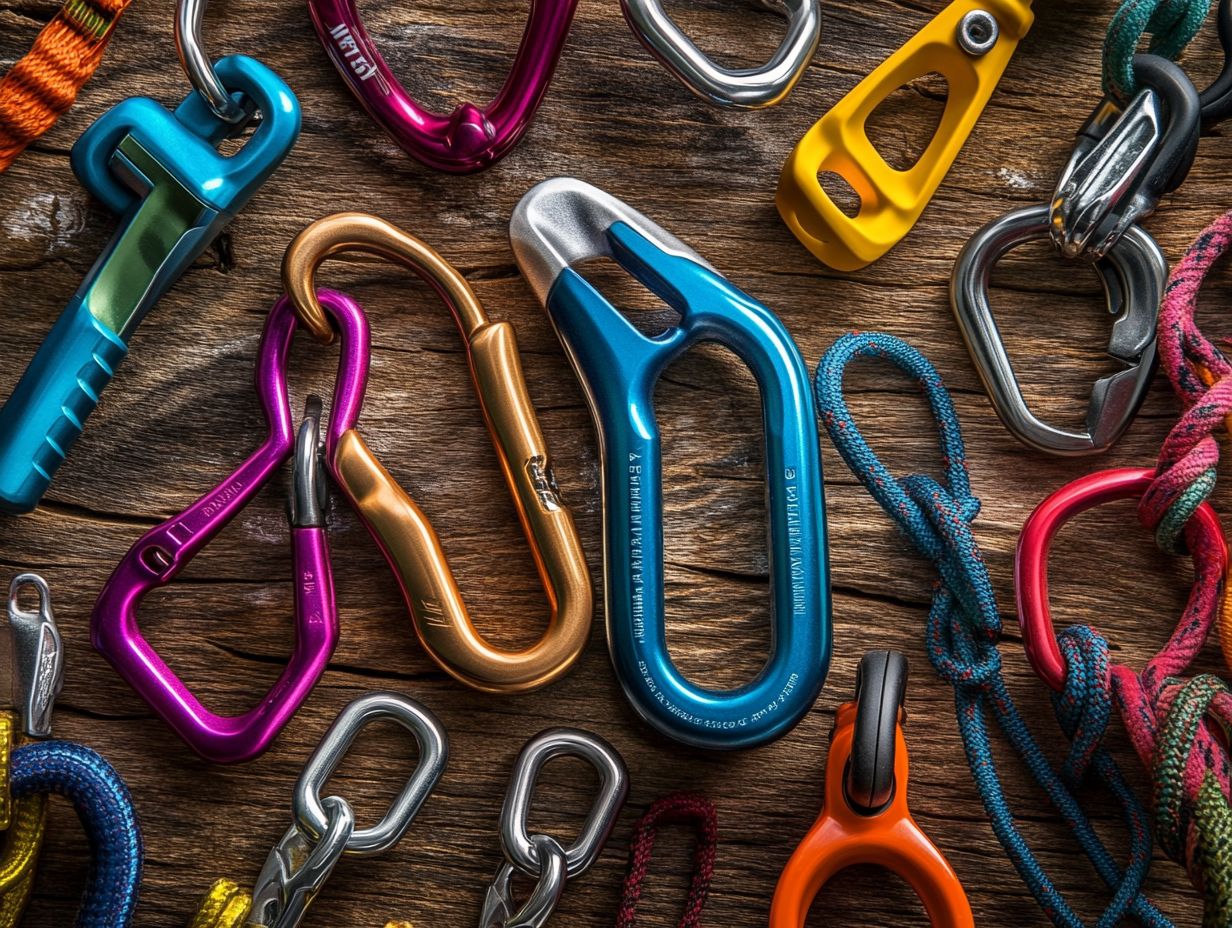
You may encounter several common misconceptions about carabiners, especially concerning their safety, locking mechanisms, strength, and weight. These misunderstandings can lead to improper use, significantly heightening the risks associated with climbing activities.
Knowing these aspects is vital for your safety and boosting your climbing performance!
Debunking Myths and Clarifying Facts
Debunking the myths surrounding carabiners is essential for ensuring your safety as a climber, particularly when it comes to their locking mechanisms, strength, and intended use.
Many climbers may fall into the trap of believing that all carabiners can handle the same loads or that non-locking versions offer the same level of security as their locking counterparts. This misconception can lead to serious accidents if you re unaware of the specific types designed for various applications, whether it s sport climbing, mountaineering, or rescue operations.
Understanding these differences is crucial, as it helps you choose the right gear for your adventures. Misunderstandings about proper usage such as improperly attaching multiple carabiners or overloading them can also jeopardize your safety.
By addressing these myths and providing accurate information, you can make informed choices and elevate your overall climbing experience.
Safety Tips for Climbing with Carabiners
Safety tips for climbing with carabiners are crucial for a secure and enjoyable experience. Always prioritize your precautions and techniques.
Proper attachment protocols and effective use of locking mechanisms are key. Understand how energy moves during falls to enhance your safety.
Be aware of the effects of cross-loading. Maintain a thorough gear check routine to reduce risks while climbing.
Precautions and Techniques for Safe Climbing
Mastering locking mechanisms and ensuring secure attachments is vital. Keep the environmental conditions in mind, such as weather changes that can affect performance.
Select high-quality aluminum carabiners with reliable locking systems. Practice using these locks to ensure they are secure during climbs and prevent accidental openings.
Always check that the carabiner is correctly oriented. This prevents cross-loading and maximizes safety.
Stay alert to weather changes. Rain or extreme temperatures can greatly impact gear performance.
Familiarize yourself with local climbing regulations and ecological considerations. This helps ensure responsible and sustainable climbing practices.
Frequently Asked Questions
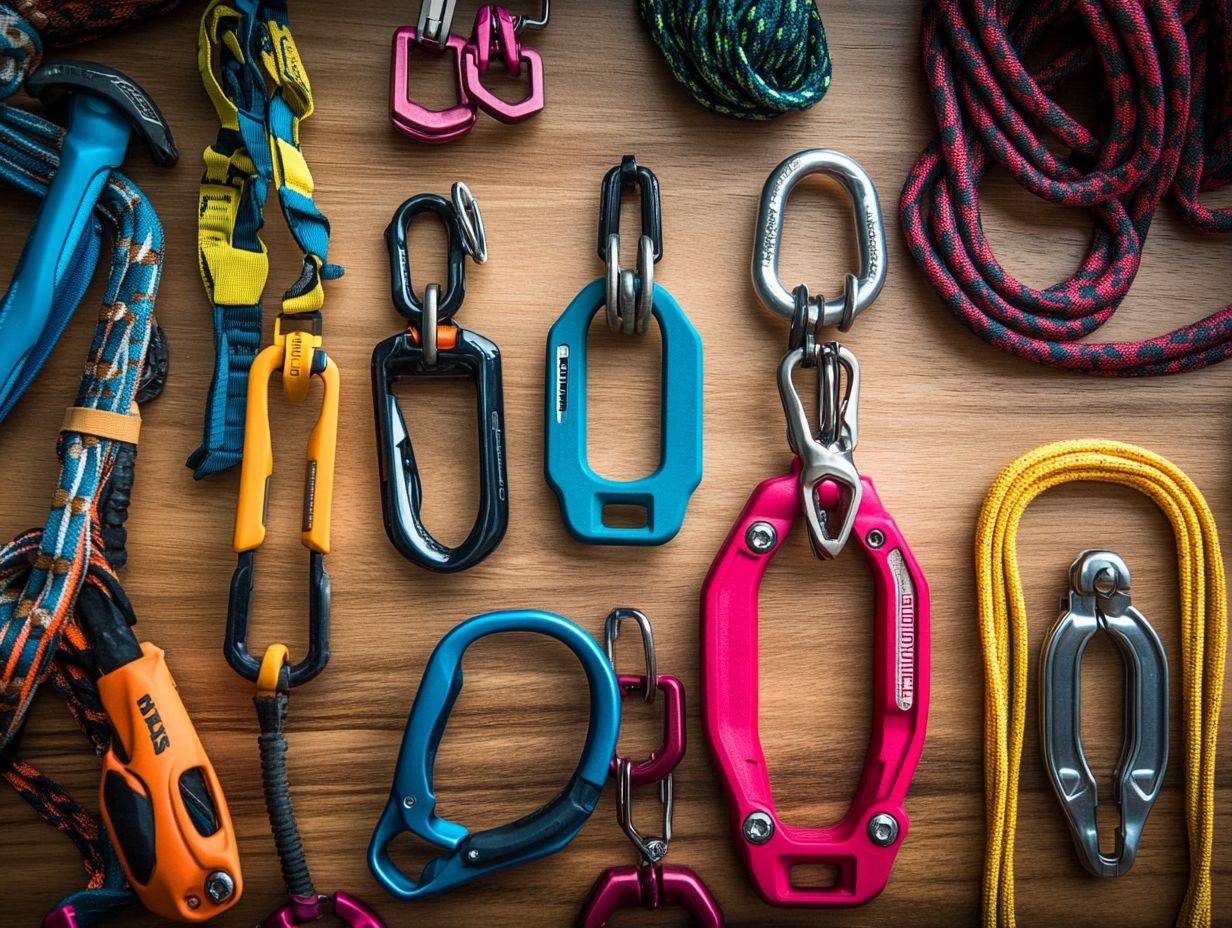
What is a carabiner and why is it important for climbing?
A carabiner is a metal clip used in rock climbing to secure ropes and equipment. It’s essential for providing a strong, reliable connection.
What are the different types of carabiners and how do I know which one to use?
There are three main types: locking, non-locking, and wire gate. Choose based on your climbing needs: locking for critical connections, non-locking for lighter tasks, and wire gate for weight savings.
What is the difference between the strength ratings of carabiners?
Carabiners have two ratings: major axis and minor axis. Always apply force on the major axis for maximum strength and safety.
Can carabiners be used for anything other than climbing?
Yes, they are also useful for camping, hiking, and everyday tasks, like carrying keys. However, use them only for their intended purpose.
How often should I replace my carabiners?
Regularly inspect your carabiners for wear or damage. Replace them immediately if issues arise, and consider replacing them every 5 years or sooner if they show signs of heavy use.
How should I care for my carabiners?
To make your carabiners last longer, take good care of them. Clean them regularly with mild detergent and water.
Avoid harsh chemicals or solvents. Store them in a dry, cool place.
Avoid dropping or slamming carabiners to prevent damage. With proper care, your carabiners will serve you well on every adventure!

